Sep 10, 2006
Nanowires Listen In on Neurons
Via Neuroguy
MIT’s Technology Review has an interesting article that describes the development of silicon nanowires to measure small electrical signals on the same neuron:
The research group, led by Charles Lieber, professor of chemistry at Harvard University, has developed techniques for synthesizing large arrays of silicon nanowires, which act as transistors, amplifying very small electrical signals from as many as 50 places on a single neuron. In contrast, the most precise existing methods can pick up only one or two signals from a neuron. By detecting electrical activity in many places along a neuron, the researchers can watch how it processes and acts on incoming signals from other cells.The nanowires are about the same size as the branches that neurons use to communicate with one another. William Ditto, professor of biomedical engineering at the University of Florida, says neurons probably send the same kinds of signals to the nanowires as they do to other neurons. As a result, the nanowires could provide a realistic view of a neuron’s complex firing patterns.
21:21 Posted in Neurotechnology & neuroinformatics, Research tools | Permalink | Comments (0) | Tags: neurotechnology
Jul 29, 2006
Brain-activity interpretation competition won by Italian researchers
Via Mind Hacks

A team of three Italian researchers (Emanuele Olivetti, Diego Sona, and Sriharsha Veeramachaneni) won $10000 in a brain-activity interpretation competition. Entrants were provided with the fMRI data and behavioural reports recorded when four people watched two movies. The competitors' task was to create an algorithm that could use the viewers ongoing brain activity to predict what they were thinking and feeling as the film unfolded.
The Italian team resulted to be the most accurate, with a correlation of .86 for basic features, such as whether an instant of the film contained music. The full results are here.
20:55 Posted in Brain-computer interface, Neurotechnology & neuroinformatics, Persuasive technology | Permalink | Comments (0) | Tags: brain-computer interface
Jul 20, 2006
Using thought power to control artificial limbs
Nature 442, 164-171(13 July 2006)
Leigh R. Hochberg, Mijail D. Serruya, Gerhard M. Friehs, Jon A. Mukand, Maryam Saleh, Abraham H. Caplan, Almut Branner, David Chen, Richard D. Penn and John P. Donoghue
Neuromotor prostheses (NMPs) aim to replace or restore lost motor functions in paralysed humans by routeing movement-related signals from the brain, around damaged parts of the nervous system, to external effectors. To translate preclinical results from intact animals to a clinically useful NMP, movement signals must persist in cortex after spinal cord injury and be engaged by movement intent when sensory inputs and limb movement are long absent. Furthermore, NMPs would require that intention-driven neuronal activity be converted into a control signal that enables useful tasks. Here we show initial results for a tetraplegic human (MN) using a pilot NMP. Neuronal ensemble activity recorded through a 96-microelectrode array implanted in primary motor cortex demonstrated that intended hand motion modulates cortical spiking patterns three years after spinal cord injury. Decoders were created, providing a 'neural cursor' with which MN opened simulated e-mail and operated devices such as a television, even while conversing. Furthermore, MN used neural control to open and close a prosthetic hand, and perform rudimentary actions with a multi-jointed robotic arm. These early results suggest that NMPs based upon intracortical neuronal ensemble spiking activity could provide a valuable new neurotechnology to restore independence for humans with paralysis.
23:59 Posted in Brain-computer interface, Neurotechnology & neuroinformatics, Virtual worlds | Permalink | Comments (0) | Tags: brain-computer interface
Jul 19, 2006
Brain box
BBC News, july 17, 2006
BBC reports that researchers from University of Manchester are developing a new biologically-inspired computer, which mimics the complex interactions between brain neurons.
The computer will be designed with the aim of modelling large numbers of neurons in real time and to track patterns of neural spikes as they occur in the brain. It will be built using large numbers of simple microprocessors designed to interact like the networks of neurons found in the brain. The aim will be to place dozens of microprocessors on single silicon chip reducing the cost and power consumption of the computer.
Read the original article
20:08 Posted in Information visualization, Neurotechnology & neuroinformatics, Research tools | Permalink | Comments (0)
Jul 18, 2006
Definition of neuroinformatics
The website Pharmabiz provides a good definition of Neuroinformatics:
In this discipline work is focused on the integration of neuroscientific information from the level of the genome to the level of human behavior. A major goal of this new discipline is to produce digital capabilities for a web-based information management system in the form of databases and associated data management tools. The databases and software tools are being designed for the benefit of neuroscientists, behavioral scientists, clinicians and educators in an effort to better understand brain structure, function, and development. Some of the databases developed in Neuroinformatics are Surface Management System (SuMS), The fMRIDC, BrainMap, BrainInfo, X-Anat, The Brain Architecture Management System (BAMS), The Ligand Gated Ion Channel database (LGICdb), ModelDB and Probabilistic atlas and reference system for the human brain. Most of these databases are freely available and can be accessed through internet. They provide the particular information in detail at one place and help in the neuroscience research. Some of the generally used neuroinformatic software tools include GENESIS, NEURON, Catacomb, Channelab, HHsim, NEOSIM, NANS, SNNAP, etc. The data sharing in neuroscience is not the only application of neuroinformatics, it is much more. The computational modeling of ion channels, various parts of neurons, full neurons and even neural networks helps to understand the complex neural system and its working. This type of modeling greatly overlaps with system biology and also gets benefit from bioinformatics databases. In India neuroinformatics research is mainly being carrying out presently at National Brain Research Centre, Gurgaon under the department of biotechnology, government of India. The computational modeling of various processes related to neurosciences helps in understanding of brain functions in normal and various disorder states. Several efforts in this direction are also in progress.
00:14 Posted in Neurotechnology & neuroinformatics | Permalink | Comments (0)
BrainMap
BrainMap is an online database of published functional neuroimaging experiments with coordinate-based (Talairach) activation locations. The goal of BrainMap is to provide a vehicle to share methods and results of brain functional imaging studies. It is a tool to rapidly retrieve and understand studies in specific research domains, such as language, memory, attention, reasoning, emotion, and perception, and to perform meta-analyses of like studies.
BrainMap was created and developed by Peter T. Fox and Jack L. Lancaster of the Research Imaging Center of the University of Texas Health Science Center San Antonio.
00:11 Posted in Neurotechnology & neuroinformatics, Research tools | Permalink | Comments (0) | Tags: neuroinformatics
Second Geoethical Nanotechnology workshop
Re-blogged from KurzweilAI.net
The Terasem Movement announced today that its Second Geoethical Nanotechnology workshop will be held July 20, 2006 in Lincoln, Vermont. The public is invited to participate via conference call.The workshop will explore the ethics of neuronanotechnology and future mind-machine interfaces, including preservation of consciousness, implications for a future in which human and digital species merge, and dispersion of consciousness to the cosmos, featuring leading scientists and other experts in these areas.
The workshop proceedings are open to the public via real-time conference call and will be archived online for free public access. The public is invited to call a toll-free conference-call dial-in line from 9:00 a.m. - 6:00 p.m. ET. Callers from the continental US and Canada can dial 1-800-967-7135; other countries: (00+1) 719-457-2626.
Each workshop presentation is designed for a 15-20 minute delivery, followed by a 20 minute formal question and answer period, during which time questions from the worldwide audience will be invited. Presentations will also be available on the workshop's website
00:05 Posted in Brain training & cognitive enhancement, Brain-computer interface, Neurotechnology & neuroinformatics | Permalink | Comments (0) | Tags: neurotechnology
Jul 06, 2006
Recording of electrical activity by a multi-transistor array (MTA)
M. Hutzler, A. Lambacher, B. Eversmann, M. Jenkner, R. Thewes, and P. Fromherz
Journal of Neuropyhsiology. Preprint online (May 10, 2006).
We report on the recording of electrical activity in cultured hippocampal slices by a multi-transistor array (MTA) with 16384 elements. Time-resolved imaging is achieved with a resolution of 7.8 µm on an area of 1 mm2 at 2 kHz. A read-out of fewer elements allows an enhanced time resolution. Individual transistor signals are caused by local evoked field potentials. They agree with micropipette measurements in amplitude and shape. The spatial continuity of the records provides time-resolved images of evoked field potentials and allows the detection of functional correlations over large distances. As examples, fast propagating waves of presynaptic action potentials are recorded as well as patterns of excitatory postsynaptic potentials across and along cornu ammonis.
00:10 Posted in Neurotechnology & neuroinformatics | Permalink | Comments (0) | Tags: neurotechnology
Jul 03, 2006
Navigated brain stimulation
Via Emerging Technology Trends
A young Finnish company, Nexstim, has developed a non-invasive brain scanning and stimulation system called navigated brain stimulation (NBS). This system is already in use in 20 hospitals worldwide.
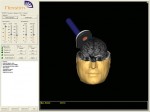
From the company's website:
Medical professionals have always dreamt of the ability to actively reach into the brain - touch instead of looking. Modern brain scanners, such as MRI, already offer sophisticated views into the human brain. Yet, these images are passive views of structures.
Nexstim's Navigated Brain Stimulation (NBS) system reaches actively into the brain. NBS guides the precise delivery of targeted transcranial magnetic stimulation (TMS) pulses to discrete brain areas. The eXimia NBS system is the only device available for accurate prediction of the TMS stimulus location and dose within the human brain.
The safe and non-invasive mapping using eXimia NBS can support neurologists and neurosurgeons to diagnoze and treat the human brain diseases, trauma, and dysfunctions.
The earliest possible diagnosis of neuronal disorders rely on detection of functional changes with active, interventive tools such as NBS.

23:52 Posted in Neurotechnology & neuroinformatics | Permalink | Comments (0) | Tags: neuroinformatics
Jun 18, 2006
Exceptional counting ability induced by temporarily switching off brain region
Via KurzweilAI.net
Applying transcranial magnetic stimulation (TMS) to the left anterior temporal lobe allow for temporary exceptional counting and calculating abilities similar to those of autistic savants, according to Allan Snyder of Australian National University. ...
18:14 Posted in Neurotechnology & neuroinformatics | Permalink | Comments (0)
Jun 01, 2006
The future of computer vision
Via Smart Mobs
Will computer see as we do? MIT researchers are developing new methods to train computers to recognize people or objects in still images and in videos with 95 to 98 percent accuracy.
This research could soon be used in surveillance cameras.
Links: Primidi
19:03 Posted in Neurotechnology & neuroinformatics | Permalink | Comments (0) | Tags: artificial intelligence
MEDGADGET: Neurotechnology Provides Hope for the Paralyzed
Via Medgadget

Cyberkinetics Neurotechnology Systems Inc. is currently focused on the commercialization of two proprietary platforms for neural stimulation, neural sensing in the brain and real-time neural signal decoding technology. These unique and powerful platforms can restore sensation, communication, limb movement as well as other bodily functions.
The BrainGate™ Neural Interface System is currently the subject of a pilot clinical trial being conducted under an Investigational Device Exemption (IDE) from the FDA. The system is designed to restore functionality for a limited, immobile group of severely motor-impaired individuals. It is expected that people using the BrainGate™ System will employ a personal computer as the gateway to a range of self-directed activities. These activities may extend beyond typical computer functions (e.g., communication) to include the control of objects in the environment such as a telephone, a television and lights...
The NeuroPort™ System is an FDA cleared medical device intended for temporary (< 30 days) recording and monitoring of brain electrical activity.
The NeuroPort™ System is based on Cyberkinetics' BrainGate™technology and consists of two parts, the NeuroPort™ Cortical Microelectrode Array (NeuroPort™ Array) and the NeuroPort™ Neural Signal Processor (NeuroPort™ NSP). The NeuroPort™ Array senses action potentials from individual neurons in the brain. The NeuroPort™ NSP records these high resolution signals and provides a physician with the tools to analyze them...
18:40 Posted in Neurotechnology & neuroinformatics | Permalink | Comments (0) | Tags: neuroinformatics
May 22, 2006
Neurotechnology market is raising
The MIT Technology Review has interviewed Zack Lynch, managing directory of market analysis firm NeuroInsights, about the future of neurotechnology. According to a recent report produced by Lynch's firm, 450 companies participate in the neurotechnology market, producing revenues of $110 billion in 2005.
Here is an excerpt of the interview:
Technology Review: Why neurotechnology?Zack Lynch: Neuroscience is now moving from a science to an industry. What we're really looking at is an evolution: researchers are now going beyond basic science and developing more effective therapeutics for brain-related illnesses.
The need is huge. One in four people worldwide suffer from a brain-related illness, which costs a trillion dollars a year in indirect and direct economic costs. We all know someone who is affected. That burden will continue to grow with the aging population. We have more people, and more people living longer -- it's a multiplier effect.
TR: We're also starting to see a new kind of therapy for brain-related illnesses -- electrical stimulation. Various types of stimulation devices are now on the market to treat epilepsy, depression, and Parkinson's disease. What are some of the near- and far-term technologies we'll see with this kind of device?
ZL: We're seeing explosive growth in this area because scientists are overcoming many of the hurdles in this area. One example is longer battery life, so devices don't have to be surgically implanted every five years. Researchers are also developing much smaller devices. Advanced Bionics, for example, has a next-generation stimulator in trials for migraines.
In the neurodevice space, the obesity market is coming on strong. Several companies are working on this, including Medtronics and Leptos Biomedical. In obesity, even a small benefit is a breakthrough, because gastric bypass surgery [one of the most common treatments for morbid obesity] is so invasive.
In the next 10 years, I think we'll start to see a combination of technologies, like maybe a brain stimulator that releases L-dopa [a treatment for Parkinson's disease]. Whether that's viable is a whole other question, but that possibility is there because of the microelectronics revolution.
The real breakthrough will come from work on new electrodes. This will transform neurostimulator applications. With these technologies, you can create noninvasive devices and target very specific parts of the brain. It's like going from a Model T to a Ferrari. Those technologies will present the real competition for drugs.
22:42 Posted in Neurotechnology & neuroinformatics | Permalink | Comments (0) | Tags: Positive Technology
May 13, 2006
Nanotubes used for first time to send signals to nerve cells
Via Medgadget
Researchers from the University of Texas Medical Branch and Rice University have succesfully tested the ability of carbon nanotubes to carry electrical signals to nerve cells. From the press release:
The group employed two different types of cells in their experiments, neuroblastoma cells commonly used in test-tube experiments and neurons cultured from experimental rats. Both cell types were placed on ten-layer-thick "mats" of single-walled carbon nanotubes (SWNTs) deposited on transparent plastic. This enabled the researchers to use a microscope to position a tiny electrode next to individual cells and record their responses to electrical pulses transmitted through the SWNTs.In addition to their electrical stimulation experiments, the scientists also studied how different kinds of SWNTs affected the growth and development of neuroblastoma cells. They compared cells placed on mats made of "functionalized" SWNTs, carbon nanotubes with additional molecules attached to their surfaces that may be used to guide cell growth or customize nanotube electrical properties, to cells cultured on unmodified "native" carbon nanotubes and conventional tissue culture plastic.
"Native carbon nanotubes support neuron attachment and growth well - as we expected, better than the two types of functionalized nanotubes we tested," Pappas said. [Todd Pappas, director of sensory and molecular neuroengineering at UTMB's Center for Biomedical Engineering -ed.] "Next we want to find a way to functionalize the nanotubes to make neuron attachment and communication better and make these surfaces more biocompatible."
Read the full press release
19:40 Posted in Neurotechnology & neuroinformatics | Permalink | Comments (0) | Tags: Positive Technology
May 01, 2006
ENKI
Via WMMNA
In the field of psychology, it has long been known that brain wave activity of persons subjected to a light flashing at a certain frequency would fall in sync with the flashing of the lights. Drawing on this observation, several devices have been developed to entrain brain waves. These systems are used by psychologists in their practices and by the general public for relaxation, stress management, insomnia, accelerated learning and retention, phobias, anxiety, fun, etc.
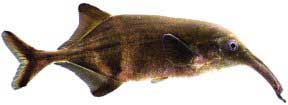
It uses sound and light pulses - to induce a state of 'extreme relaxation' similar to the way traditional Sound and Light Entrainment devices (SLEDs) work - the difference is that ENKI uses the electric communication signals from Electric Fish rather than a pre-programmed chip. Ultimately ENKI offers the possibility of becoming one with the mind of 'nature' - and by default, achieving an altered, beneficial state through this experience.

The ENKI prototype has been developed through research into interactive biotechnological systems, biophysics, as well as other, believed scientific theories and ideas, used to develop similar technologies in the realm of medicine, neuroscience and other more obscure healing technologies.

A list of movies documenting the project can be found here
11:55 Posted in Neurotechnology & neuroinformatics | Permalink | Comments (0) | Tags: Positive Technology
Deep brain stimulation (DBS): the Next Revolution in Depression Treatment?
Researchers from the Cleveland Clinic and Brown University’s Butler Hospital have conducted anl experiment to assess the potential of deep brain stimulation (DBS) for the treatment of Major Depression, the most severe category of depression. In a MD, more of the symptoms of depression are present, and they are usually more intense or severe.
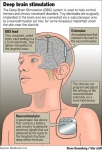
Participants underwent standardized and detailed psychiatric, quality-of-life, and neuropsychological assessments on a regularly scheduled basis, both pre- and postsurgically. At a minimum of six months postsurgery, four of the six patients showed a clinically significant reduction in depression severity of 50 percent or greater on the Montgomery-Asberg Depression Rating Scale. Quality-of-life measures improved as well, and patients showed progressive improvements in mood and functioning over time. One patient experienced persistent occipital pain that was alleviated with repositioning of a subcutaneous connector wire.

Larger-scale clinical trials are needed to demonstrate the effectiveness (or lack thereof) of the DBS treatment for depression.
11:00 Posted in Neurotechnology & neuroinformatics | Permalink | Comments (0) | Tags: Positive Technology
Apr 27, 2006
Researchers develop thought-controlled limbs
From VRoot.org (via MSNBC)
With Pentagon support, researchers develop thought-controlled limbs. Work on artificial arms that would be controlled by the human mind is ramping up, thanks to a helping financial hand from the Defense Advanced Research Projects Agency. DARPA announced in February that it would pour $55 million into a prosthetic arm research project to be led by Johns Hopkins University’s Applied Physics Laboratory. The work will be spread among more than two dozen institutions.
23:10 Posted in Neurotechnology & neuroinformatics | Permalink | Comments (0) | Tags: Positive Technology
Deep Brain Stimulation Shows Promise in Treatment of Obsessive Compulsive Disorder
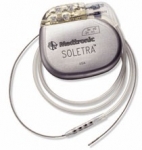
DBS has been used to treat intractable pain for several decades, and more recently, use of this technology has expanded to the FDA-approved indications for Parkinson’s disease and other movement disorders. DBS is also under investigation in the treatment of epilepsy and other debilitating neurological conditions. DBS surgery involves the placement of tiny implantable electrodes into specific parts of the brain that are functioning abnormally. These electrodes emit tiny pulses of electrical stimulation to block the abnormal activity in the brain, which causes a variety of symptoms – such as pain, tremors, movement problems; as well as obsessions, moods and anxieties associated with psychiatric disorders. The success of DBS is dependent on the surgical team’s ability to precisely pinpoint the specific brain area for stimulation. The advantage of DBS is that it is reversible, nondestructive, and can be modified by adjustment of the stimulator settings after implantation.
This study was conducted with Institutional Review Board (IRB) and Food and Drug Administration (FDA) Investigational Device Exemptions (IDE) approval. Six patients, four females and two males, with an average age of 48, were enrolled in the study from 2003 to 2005. All six patients had a history of being highly resistant to other treatments, including medication, psychotherapy, and electroconvulsive therapy (ECT). Bilateral DBS leads were implanted stereotactically in a region of the brain known as the ventral anterior internal capsule. Participants underwent standardized and detailed psychiatric, quality-of-life, and neuropsychological assessments on a regularly scheduled basis, both pre- and postsurgically.
At a minimum of six months postsurgery, four of the six patients showed a clinically significant reduction in depression severity of 50 percent or greater on the Montgomery-Asberg Depression Rating Scale. Quality-of-life measures improved as well, and patients showed progressive improvements in mood and functioning over time. One patient experienced persistent occipital pain that was alleviated with repositioning of a subcutaneous connector wire.
22:58 Posted in Neurotechnology & neuroinformatics | Permalink | Comments (0) | Tags: Positive Technology
Apr 25, 2006
VRoot.org -: Neural Interfaces: Scientists Probe the Use of the Tongue
PENSACOLA, Fla. - In their quest to create the super warrior of the future, some military researchers aren't focusing on organs like muscles or hearts. They're looking at tongues. By routing signals from helmet-mounted cameras, sonar and other equipment through the tongue to the brain, they hope to give elite soldiers superhuman senses similar to owls, snakes and fish.
23:27 Posted in Neurotechnology & neuroinformatics | Permalink | Comments (0) | Tags: Positive Technology
Neuroelectronics
Via Mind Hacks
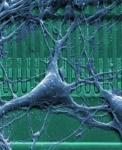
The New Atlantis has a comprehensive article on 'neuroelectronics' - the science of interfacing digital components with neural wetware. From the article:
The potential merging of mind and machine thrills, frightens, and intrigues us. For decades, experiments at the border between brains and electronics have led to sensationalistic media coverage, vivid science fiction portrayals, and dreams of cyborgs and bionic men. But recently, this area of science has seen remarkable advances—from robotic limbs controlled directly by brain activity, to brain implants that alter the mood of the depressed, to rats steered by remote control. Adam Keiper explores the peculiar history and present directions of this research, and considers the challenges of staying human in the age of neuroelectronics.
23:11 Posted in Neurotechnology & neuroinformatics | Permalink | Comments (0) | Tags: Positive Technology








